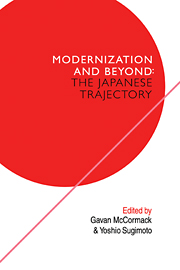Book contents
- Frontmatter
- Contents
- Contributors
- Introduction: modernization and beyond
- I Popular culture: tradition and ‘modernization’
- II Popular movements: alternative visions of ‘modernization’
- III Uneven development and its discontents
- 6 The other side of Meiji: conflict and conflict management
- 7 Nuclear power and the labour movement
- 8 Street labour markets, day labourers and the structure of oppression
- IV Sex, politics and ‘modernity’
- V ‘Modernization’ and ‘modernity’: theoretical perspectives
- Glossary
- Index
6 - The other side of Meiji: conflict and conflict management
Published online by Cambridge University Press: 04 August 2010
- Frontmatter
- Contents
- Contributors
- Introduction: modernization and beyond
- I Popular culture: tradition and ‘modernization’
- II Popular movements: alternative visions of ‘modernization’
- III Uneven development and its discontents
- 6 The other side of Meiji: conflict and conflict management
- 7 Nuclear power and the labour movement
- 8 Street labour markets, day labourers and the structure of oppression
- IV Sex, politics and ‘modernity’
- V ‘Modernization’ and ‘modernity’: theoretical perspectives
- Glossary
- Index
Summary
INTRODUCTION
The political and intellectual conflicts evident in the early years of Meiji were not just ineffectual, populist responses to industrial modernization and institutional change. Alternative political and industrial programmes were developed by groups who extended in influence from the dissidents who were within or ex-members of the strategic elite, through both metropolitan and provincial intellectuals who remained outside the immediate vortex of the political executive, to popular societies, newspapers and discussion groups.
Conflict, especially at its most ‘popular’ level, was often successfully contained by the direct, interventionist measures of the State. Intellectual opposition was contained by the process of economic change itself. This was possible due to the nature of both the ascribed and achieved social configurations of the opposition intellectuals. This hypothesis requires a fairly complex argument.
The politics of containment generates economic wastage. The size of that waste during a period of profound industrial development depends to a great extent on the nature of technology transfer, adoption and diffusion.
THE OTHER SIDE OF MEIJI
Many writers simply ignore the extent of intellectual and political threat during the 1870s. Others interpret it as real but essentially limited to the clarification of elite goals, i.e., to be non-goal threatening. Thus Harootunian's premise is that ‘the existence of a strong strategic elite in the initial stages of modernization is more important than a comprehensive design for change of a variety of politically articulate groups competing with each other’.
- Type
- Chapter
- Information
- The Japanese TrajectoryModernization and Beyond, pp. 107 - 128Publisher: Cambridge University PressPrint publication year: 1988
- 8
- Cited by

